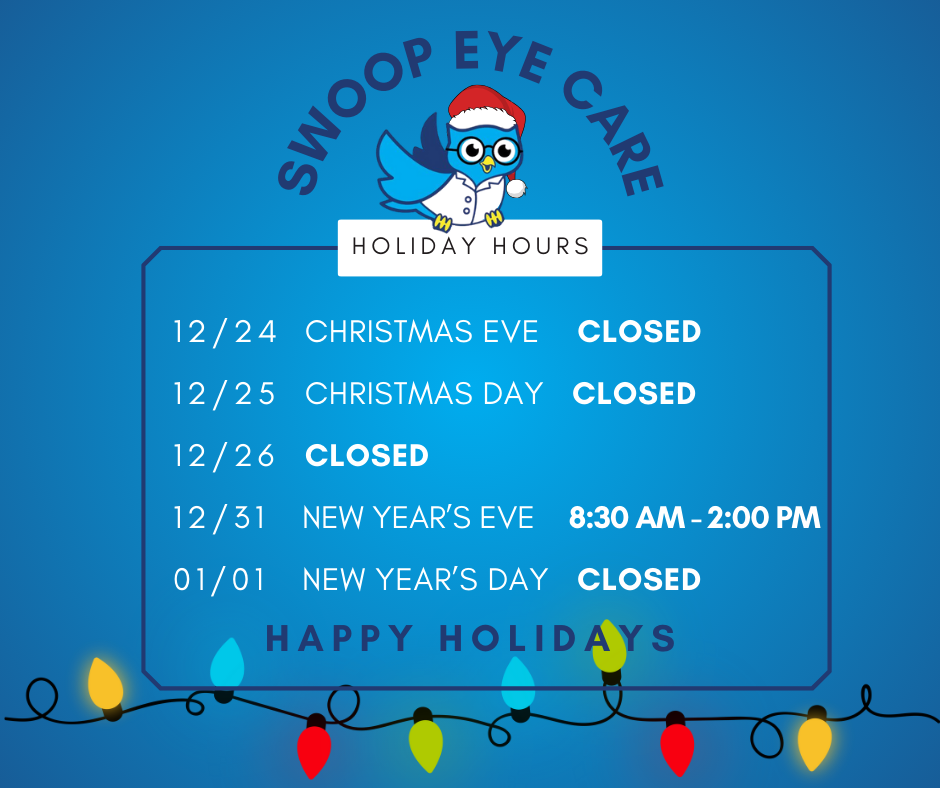Overview

Dry eye is a condition that affects the front surface tear film. The tear film is made up of an oily layer, watery layer, and mucus layer. If one or more of these specific components are affected, a person will develop symptoms and/or signs of dry eyes.
Dry Eye Treatment Options
- Over-the-Counter Eye Drops (artificial tears, rewetting drops, etc.)
- Prescription Eye Drops
- Oral Supplements
- Nasal Spray
- Warm Compresses
- Eyelid Cleaners
- Punctal Plugs
- Lifestyle Changes
- Environment
What are symptoms/signs of dry eyes?
- Burning or stinging
- Gritty or sand in your eye feeling
- Intermittent blurry vision (improves on the blink)
- Red eyes
- Painful to wear contact lenses
- Watery or profuse tearing (wow – why would my eyes do that!)
What are some causes of dry eye?
- Systemic medications
- Overwearing contact lenses
- History of refractive eye surgery (LASIK, PRK, etc.)
- Computer use
- Environmental factors (windy day, dry environment)
- Other eye diseases
- Systemic diseases (lupus, rheumatoid arthritis, Sjogren’s syndrome, thyroid disease, diabetes, and many others)
How does my optometrist diagnose or evaluate dry eyes?
Your optometrist will complete a thorough eye examination by paying special attention to the tear film (surface of your eye), eyelid structures, and mechanism of your blink. Special tests will often be used to help diagnose dry eyes, as dry eye varies amongst patients.
What are some treatment options available to treat dry eyes?
- Over-the-counter eye drops
- Prescribed eye drops
- Oral supplements
- Nasal spray
- Warm compresses
- Eyelid cleaners
- Punctal plugs
There are so many eye drops at your local convenient store or pharmacy! When treating dry eye, it is important to learn what type of dry eye you have. Once determined, your eye doctor will recommend a specific type.
Eye Drops – Mixed Use
- Defined: combination of both evaporative and aqueous deficient dry eye
- Recommendation: Systane Complete or Refresh Digital
Eye Drops – Evaporative Forms
- Defined: not creating enough oil from the eyelid glands protecting the front surface
- Recommendation: Refresh Mega 3
Eye Drops – Aqueous Deficient Dry Eye
- Defined: lack of production of the watery layer of the tear film
- Recommendation: Systane Hydration or Refresh Relieva
Prescription eye drops are another option for patients not experiencing relief using other dry eye therapies. The three most common eye drops for long-term relief are Restasis, Xiidra, and Cequa. There is a short-term prescribed eye drop to improve acute dry eye known as Eysuvis. Please talk with your eye doctor to determine if one of these options may be right for you.
Omega 3 supplements or fish oils are often recommended for patients with a particular type of dry eye. We recommend speaking with your eye doctor to determine if this is a right treatment or ancillary treatment option.
Wallerich Eye Care typically recommends PRN (Physician Recommended Nutraceuticals) products given the effectiveness and objective nature of the products. In addition, there are VEGAN products offered for our patients with dietary restrictions or lifestyle preferences.
Your optometrist has another tool to treat dry eye symptoms known as Tyrvaya. Tyrvaya is a nasal spray that activates the tearing mechanism of the eye to combat dry eye symptoms. Check with your eye doctor to determine if this is an option for you!
Warm compresses are recommended for patients with meibomian gland dysfunction or a subtype of dry eye syndrome. Look at Dr. Allen’s recommendations for the most effective way! Talk with your eye doctor if you would like to purchase a Bruder mask in office!
Eyelid cleaners are recommended when patients develop crustiness around the eyelid. It is important to work with your optometrist to discuss the cause of the crustiness and to determine if eyelid cleaners are the most appropriate treatment option. Some products that may be recommended are as follows (make sure to follow the directions printed on the products instructions):
- Ocusoft pads (wipes)
- Avenova Products (Wipes or Spray)
- Heyedrate (Tea Tree Face Wash)
Punctal plugs are small dissolvable or non-dissolvable devices that are inserted into the tear ducts to prevent the flow or drainage of your tears. By blocking the drainage duct, it allows a reservoir of tears to form to improve dry eye symptoms. It is important to work with your eye doctor to determine if this is the right option for you.
Often, your optometrist will recommend dissolvable punctal plugs to ensure dry eye symptom improvement and to ensure comfort (no itchiness, tears running down your face/cheek, foreign body sensation on the eyelid). After 3-6 months, the dissolvable punctal plugs will need to be replaced or a more permanent option may be selected. While very rare, eyelid infections can occur, which would warrant the removal of the punctal plugs and treatment for the eyelid infection.
Talk with your optometrist to determine the best treatment option.
There are many lifestyle habits that have the potential to increase the risk of dry eyes. Some these may include:
- Vaping
- Smoking
- Cosmetics
- Screen time on digital devices
- Sleep issues
- Contact lens wear
- Diet
While these are only a few lifestyle risks that may increase the risk of dry eyes, there are many more that patients can consider when talking to your eye doctor.
Our everyday environment influences are symptoms/signs of dryness. We work with our patients to recommend an environment or changes to improve dryness that may include:
- Humidifier
- Indirect positioning from a ceiling fan or air conditioner
- Changing the direction of a vent








